Somebody to Love
Queen
The Zoo Crew is spinning the iconic Somebody to Love by Queen, from their 1976 album A Day at the Races, and the Zoo Freaks are surely vibing to its gospel-infused energy. This track, penned by Freddie Mercury, was heavily inspired by Aretha Franklin’s soulful gospel style, a nod Mercury himself confirmed in interviews, expressing his admiration for her and even hoping she might one day cover it. The song’s lush, multi-tracked harmonies, created by Mercury, Brian May, and Roger Taylor, mimic a 100-voice gospel choir, showcasing Queen’s meticulous studio craft. According to Peter Hince, Queen’s longtime roadie, the live performances of Somebody to Love had even more raw power than the polished studio version, with Freddie’s charisma electrifying audiences, as seen in the legendary 1982 Milton Keynes Bowl performance. Brian May once shared in an interview with Absolute Radio that the song’s vocal harmonies were built up to sound like a choir, with unused outtakes revealing the band’s experimental approach to perfecting the track. Roger Taylor, in a 1977 Circus Magazine interview, noted the song’s loose, gospel feel, calling it one of their loosest recordings, channeling Aretha’s spirit.
Another fascinating tidbit comes from a Capital Radio interview with Kenny Everett, where Freddie Mercury explained how he multi-tracked his own vocals to create the song’s rich harmonic layers, a testament to his vocal prowess and perfectionism. The song’s lyrical depth, exploring themes of loneliness, faith, and soul-searching, struck a chord, reaching #2 in the UK and #13 on the US Billboard Hot 100. Its cultural impact endured, with George Michael delivering a standout performance of it at the 1992 Freddie Mercury Tribute Concert, later released on the Five Live EP, which topped UK charts. Social media posts from @brianmaycom in 2020 celebrated the song’s 44th anniversary, highlighting its release as the lead single from A Day at the Races alongside May’s White Man as the B-side. The song’s music video, filmed at Wessex Studios, blended studio and live footage, though John Deacon’s mic was famously kept low, as he admitted to not singing on the record.
Queen’s journey began in London in 1970, born from the ashes of a band called Smile, which featured Brian May and Roger Taylor. As noted in a 2023 post by @carlquintanilla, the band officially became Queen on June 27, 1970, when they performed under the new name for the first time. Freddie Mercury, then Farrokh Bulsara, joined as lead vocalist, bringing his theatrical flair and extraordinary vocal range, while John Deacon completed the lineup on bass in 1971. Mercury’s vision for a genre-defying sound—blending rock, opera, and glam—set Queen apart. Their early gigs in London clubs, like the Marquee, built a cult following, and their 1973 self-titled debut album marked their arrival, though it was Sheer Heart Attack (1974) and A Night at the Opera (1975) that catapulted them to global fame. Mercury’s showmanship, May’s distinctive guitar, Taylor’s dynamic drumming, and Deacon’s understated grooves formed a unique alchemy, driven by their shared commitment to pushing musical boundaries.
Fans can connect with Queen’s legacy through their official website, Facebook, Instagram, and X accounts, where updates on tours, reissues, and tributes keep the community alive. The band’s official YouTube channel also offers a treasure trove of live performances and videos. For deeper fan engagement, sites like Ultimate Queen and Queen Fandom Wiki provide detailed discographies and trivia. On Facebook, groups like Queen Fans and Queen Forever foster vibrant discussions, while forums like QueenChat offer spaces for diehards to share memories and debate favorite tracks. Whether you’re a Zoo Freak or a lifelong Queen devotee, Somebody to Love remains a timeless anthem, and Queen’s story is one of relentless creativity and enduring connection.

